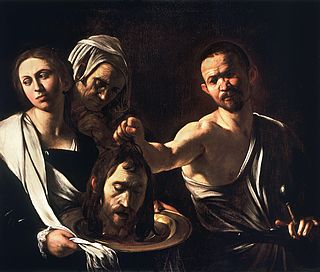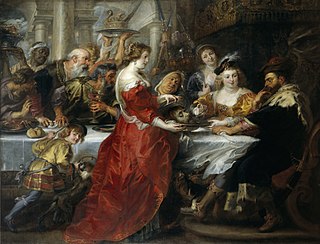Related Research Articles

John the Baptist was a Jewish preacher active in the area of the Jordan River in the early 1st century AD. He is also known as Saint John the Forerunner in Eastern Orthodoxy and Oriental Orthodoxy, John the Immerser is in some Baptist Christian traditions, Saint John by certain Catholic churches, and Prophet Yahya in Islam. He is sometimes alternatively referred to as John the Baptiser.

Salome, also known as Salome III, was a Jewish princess, the daughter of Herod II and princess Herodias. She was granddaughter of Herod the Great, and stepdaughter of Herod Antipas. She is known from the New Testament, where she is not named, and from an account by Flavius Josephus. In the New Testament, the stepdaughter of Herod Antipas demands and receives the head of John the Baptist. According to Josephus, she was first married to her uncle Philip the Tetrarch, after whose death she married her cousin Aristobulus of Chalcis, thus becoming queen of Armenia Minor.

Herodias was a princess of the Herodian dynasty of Judaea during the time of the Roman Empire. Christian writings connect her with the execution of John the Baptist.

Herod Antipas was a 1st-century ruler of Galilee and Perea. He bore the title of tetrarch and is referred to as both "Herod the Tetrarch" and "King Herod" in the New Testament. He was a son of Herod the Great and a grandson of Antipater the Idumaean. He is widely known today for accounts in the New Testament of his role in events that led to the executions of John the Baptist and Jesus of Nazareth. His father, Herod the Great, was described in the account as ordering the Massacre of the Innocents, marking the earliest Biblical account of the concerns of the government in Jerusalem regarding Jesus's existence.

Salome's Last Dance is a 1988 British film written and directed by Ken Russell. Although most of the action is a verbatim performance of Oscar Wilde's 1891 play Salome, which is itself based on a story from the New Testament, there is also a framing narrative that was written by Russell.
Matthew 11:14 is the fourteenth verse in the eleventh chapter of the Gospel of Matthew in the New Testament.
Matthew 14:4 is the fourth verse in the fourteenth chapter of the Gospel of Matthew in the New Testament.
Matthew 14:12 is the twelfth verse in the fourteenth chapter of the Gospel of Matthew in the New Testament. It refers to the death of John the Baptist and the burial of his body.

The beheading of John the Baptist, also known as the decollation of Saint John the Baptist or the beheading of the Forerunner, is a biblical event commemorated as a holy day by various Christian churches. According to the New Testament, Herod Antipas, ruler of Galilee under the Roman Empire, had imprisoned John the Baptist because he had publicly reproved Herod for divorcing his first wife and unlawfully taking his sister-in-law as his second wife Herodias. He then ordered him to be killed by beheading.

Salome is a 1953 American drama Biblical film directed by William Dieterle and produced by Buddy Adler from a screenplay by Harry Kleiner and Jesse Lasky Jr. The music score was by George Duning, the dance music by Daniele Amfitheatrof and the cinematography by Charles Lang. Rita Hayworth's costumes were designed by Jean Louis. Hayworth's dances for this film were choreographed by Valerie Bettis. This film was the last produced by Hayworth's production company, the Beckworth Corporation.
Herod II was the son of Herod the Great and Mariamne II, the daughter of Simon Boethus the High Priest, and the first husband of Herodias, daughter of Aristobulus IV and his wife Berenice. For a brief period he was his father's heir apparent, but Herod I removed him from succession in his will. Some writers call him Herod Philip I, as the Gospel of Matthew and Gospel of Mark state that Herodias was married to a "Philip". Because he was the grandson of Simon Boethus, he is sometimes also called Herod Boethus, but there is no evidence he was actually thus called during his lifetime.

Philip the Tetrarch, sometimes called Herod Philip II by modern writers was the son of Herod the Great and his fifth wife, Cleopatra of Jerusalem. As a Tetrarch, he ruled over the northeast part of his father's kingdom between 4 BCE and 34 CE after Herod's death. He was a half-brother of Herod Antipas and Herod Archelaus. He is not the same person as Herod II, whom some writers call Herod Philip I.

The Feast of Herod refers to the episode in the Gospels following the Beheading of St. John the Baptist, when Salome presents his head to her parents. The account in the Book of Mark describes Herod Antipas holding a banquet on his birthday for his high officials and military commanders, and leading men of Galilee. At this banquet, Herod's daughter dances before Herod, who is pleased and offers her anything she asks for in return. The girl asks her mother what she should request, and she is told to demand the head of John the Baptist. Reluctantly, Herod orders the beheading of John, and John's head is delivered to her, at her request, "on a platter."

The Apparition(French: L'Apparition) is a painting by French artist Gustave Moreau, painted between 1874 and 1876. It shows the biblical character of Salome dancing in front of Herod Antipas with a vision of John the Baptist's severed head. The 106 cm high and 72,2 cm wide watercolor held by the Musée d'Orsay in Paris elaborates on an episode told in the Matthew 14:6–11 and Mark 6:21–29. On a feast held for Herod Antipas' birthday, the princess Salome dances in front of the king and his guests. This pleased him so much he promises her anything she wished for. Incited by her mother Herodias, who was reproved by the John the Baptist for her illegitimate marriage to Herod, Salome demands John's head on a charger. Regretful but compelled to keep his word in front of everyone present, Herod complies with Salome's demand. John the Baptist is beheaded, his head brought on a charger and given to Salome, who in turn gives it to her mother.

Salome Dancing before Herod is an oil painting produced in 1876 by the French Symbolist artist Gustave Moreau. The subject matter is taken from the New Testament, depicting Salome—the daughter of Herod II and Herodias—dancing before Herod Antipas.

Salome by Oscar Wilde, a play written in 1891 and first produced in 1896, has been analysed by numerous literary critics, and has prompted numerous derivatives. The play depicts the events leading to the execution of Iokanaan at the instigation of Salome, step-daughter of Herod Antipas, and her death on Herod's orders.
Matthew 14:6-7 is a set of verses in the fourteenth chapter of the Gospel of Matthew in the New Testament.
Matthew 14:9-11 are verses in the fourteenth chapter of the Gospel of Matthew in the New Testament.

Salome, also known as Salome with the Head of John the Baptist, is an oil painting by the Venetian painter Titian, made in about 1550, and currently in the collection of the Museo del Prado in Madrid. It is not to be confused with other compositions of Salome and Judith by Titian.

Salome, also called Salome with the Head of John the Baptist, is an oil painting by Titian, made in around 1570, and currently in a private collection. It is not to be confused with other compositions of Salome and Judith by Titian.
References
- ↑ John MacEvilly, An Exposition of the Gospel of St. Matthew consisting of an analysis of each chapter and of a Commentary critical, exegetical, doctrinal and moral, Dublin, Gill & Son 1879.
- 1 2 3 4 "Catena Aurea: commentary on the four Gospels; collected out of the works of the Fathers. Oxford: Parker, 1874. Thomas Aquinas".
 This article incorporates text from this source, which is in the public domain .
This article incorporates text from this source, which is in the public domain .